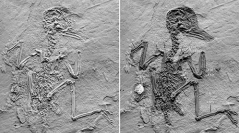

 Comptes Rendus Palevol
14 (5) - Pages 363-370
Comptes Rendus Palevol
14 (5) - Pages 363-370A new skeleton of the Early Eocene stem group mousebird Masillacolius brevidactylus is described, which for the first time provides information on the skull morphology of this unusual coliiform species. Notably, the mandible exhibits long, blade-like retroarticular processes, which were previously only known from two distantly related taxa of stem group Coliiformes. An assessment of the evolutionary significance of these structures depends on the phylogenetic interrelationships of stem group Coliiformes, which remain poorly resolved. Proceeding from recent phylogenies, the new fossil strengthens the supposition that these processes are plesiomorphic for a coliiform subclade, which also includes the extant species, and that they were secondarily reduced in crown group Coliiformes. In this case, the stem species of the clade including extant mousebirds would have exhibited feeding specializations that were lost in the evolutionary lineage leading to the extant species. Alternatively, these processes may constitute an apomorphy of a clade including Masillacolius and the Early Eocene North American Chascacocolius . In the new Masillacolius fossil a large seed is preserved, which was most likely ingested by the bird. It therefore adds another specimen to the list of coliiform fossils with seeds as stomach or gut contents and documents a long evolutionary history of frugivory in coliiform birds. This contradicts a recent proposal that birds did not play an important role as seed dispersers in the early Cenozoic.
Aves, Evolution, Frugivory, Messel, Phylogeny